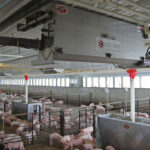Fuel In The Field
If not in its infancy, biomass farming is perhaps still toddling along. Yet, most indicators point to a significant increase in production and an additional source of revenue for farmers, as well as a variety of other benefits, depending on...
Fuel In The Field
If not in its infancy, biomass farming is perhaps still toddling along. Yet, most indicators point to a significant increase in production and an additional source of revenue for farmers, as well as a variety of other benefits, depending on...If not in its infancy, biomass farming is perhaps still toddling along. Yet, most indicators point to a significant increase in production and an additional source of revenue for farmers, as well as a variety of other benefits, depending on the crop being grown.
Signs point to a number of infrastructure, process and equipment enhancements that will make the harvesting, transportation and storage of biomass much more efficient in the next few years, if not sooner.
For starters, consider the harvesting of corn stover, which in many areas of the country can increase corn yields for the following year. Also, perennial grasses such as miscanthus and switchgrass can be grown on marginal land, require little in the way of inputs, and offer a number of environmental benefits, such as helping to filter runoff and prevent erosion.
Among such biomass-producing crops, stover already has a foothold. It’s readily available in many parts of the Corn Belt, where a partial harvest does help yields.
Now farmers and the biofuels industry are looking ahead at increased production of all things biomass, including the crops mentioned above, as well as energy sorghum, woody biomass and more. The U.S Department of Energy predicts total crop- and pastureland planted in bioenergy crops will increase from less than 10 million acres today to between 60 and 80 million acres over the next 15 years.
As a result of this increased demand, new processes and technologies are in development to help make the gathering and transport of biomass, particularly stover, more efficient and profitable for the farmer. Especially promising is single-pass harvesting, which promises the operator considerable time and fuel savings over other methods currently in use.
“AGCO has a unique solution for single-pass harvesting equipment with their new series of combines that are single-pass compatible,” says Dr. Matt Darr, assistant professor of Agricultural & Biosystems Engineering at Iowa State University. “AGCO is also a leader in the industry with single-pass baling products to provide producers and large energy companies the opportunity to make single-pass harvesting a reality within a supply chain.”
The technology in Hesston® by Massey Ferguson balers is ready-made to handle stover, as well as other biomass crops. Already, the Hesston 2170XD large square baler has earned its stripes for how densely it can pack the bulky crops, says David Ibbetson, a Kansas-based custom baler who uses two 2170XD balers to bundle some 15,000 bales each year in Iowa. He also uses Hesston round balers to bundle another 1,500-plus bales closer to his home in Yates Center.
Several other pieces of equipment that will aid in the harvesting of residue are now in the pipeline at AGCO. One such tool is a corn header that can harvest upwards of 150% higher volumes of corn and MOG. Another is a receiver chute that’s attached to the front of the baler and allows it to take in MOG without it being deposited on the ground before baling. “By having the baler accept the residue directly,” explains Maynard Herron, AGCO’s engineering manager at its Hesston, Kan., plant, “you cut in half the amount of ash in the bale. Those cleaner bales, of course, are more valuable and make this approach to stover more profitable to the farmer.”
 Watch a video of Iowa State’s Dr. Matt Darr explaining when harvesting corn stover can increase yields, save money and time, and generate revenue at http://www.myfarmlife.com/crops/the-case-for-stover/.
Watch a video of Iowa State’s Dr. Matt Darr explaining when harvesting corn stover can increase yields, save money and time, and generate revenue at http://www.myfarmlife.com/crops/the-case-for-stover/.
Continue the conversation: Do you harvest stover? If so, have you seen a benefit on your farm?
If you would like to learn more about AGCO’s Biomass Solutions, please visit: www.bit.ly/AGCOBiomass.




